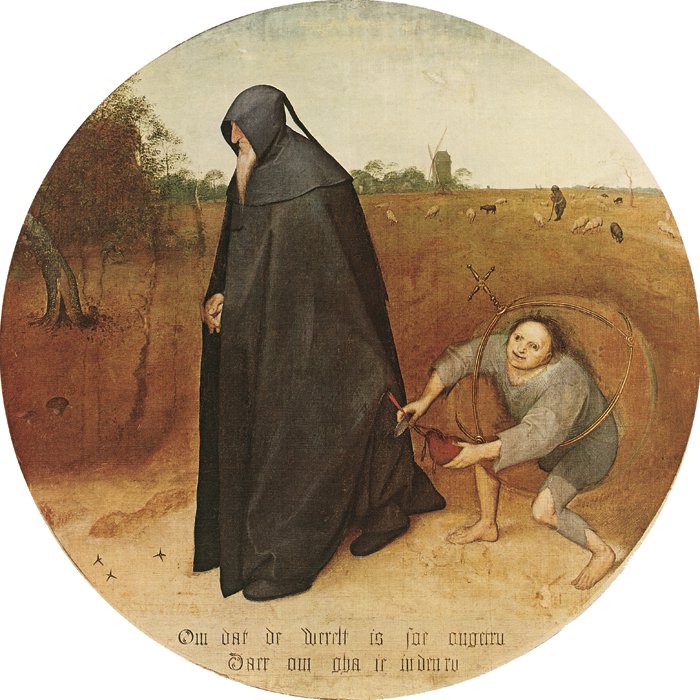46. Pieter Bruegel the Elder, The Misanthrope, 1568.
Oil on canvas, 86 x 85 cm.
Museo Nazionale di Capodimonte, Naples.
Pieter Bruegel
the Elder’s Beginnings
Nothing is less certain than Bruegel’s date of birth, but there are also many questions regarding where he was born. Because he is recorded in the liggeren or ‘Record of Artists’ of the guild of Saint Luke in Antwerp under the name of ‘Peeter Brueghels’, it is concluded that he was from the village of Bruegel. This is confirmed by the testimony of the biographer Van Mander: “Nature made a singularly fortunate choice the day she would take from among the peasants of an obscure village in Brabant, the humorous Pieter Bruegel to make him the painter of the country folk”. Continuing, Van Mander clarifies, “Pieter Bruegel was born in the neighbourhood of Breda, in a village whose name he took and transmitted to his numerous descendants”. The fact that there is no village named Bruegel near Breda already renders this affirmation suspect.
There is a Bruegel situated near Eindhoven, about ten leagues (forty kilometres) from Breda and under the governance of Bois-le-Duc. Another village named Bruegel, north of Limburg, is divided into Groote Bruegel and Kleine Bruegel, but it is about seventy kilometres from Breda, making it seem more likely that the painter was born in the first of these villages. By “in the neighbourhood of Breda”, it is not clear if Van Mander meant to specify the village nearer to Breda. Pol de Mont reports that according to tradition, Bruegel was born in this village on a farm that, until recently, was known as his birthplace.
It is clear that Bruegel was the son of a peasant. Van Mander’s testimony resists contradictions to this point. The biographer knew contemporaries of Bruegel and perhaps even received his information from the painter’s sons. Van Mander was scrupulous about the exactness of his information, and checked the biographical details that he provides about many painters, frequently complaining that it was only with great difficulty that he was able to obtain them. At least one fact, the modest origins of the painter, survived, transmitted by the generation that followed Bruegel. Therefore, it is difficult to admit the theory of Wouters who, having discovered a family of Bruegels from a higher social class, assumed that the painter had less modest origins. Nothing shows that these Bruegels were relations of the painter.
As to the spelling of the name that many write as Breugel with an eu in the place of ue, or as Breughel, inserting an h, it still seems logical to keep the spelling Bruegel. As René Van Bastelaer convincingly observed, Pieter Bruegel the Elder always signed his name with the e after the u. It is true that the paintings from his first eight years as a master are signed Brueghel, but starting in 1559, he consistently signed Bruegel.[8] However, his two sons Pieter the Younger and Jan, almost invariably signed their names Brueghel, and this designation has been preserved in the present volume when referring to these painters.
Only three dates are certain in the life of Bruegel the Elder: the date of his acceptance as a master in the Guild of Saint Luke, the date of his marriage and his death. Only hypotheses exist regarding Bruegel’s date of birth. Some scholars argue that he was born in 1510, Hymans and Van den Branden place it in 1525, and René Van Bastelaer, taking into account some important considerations, estimates it to have taken place sometime between 1528 and 1530.
